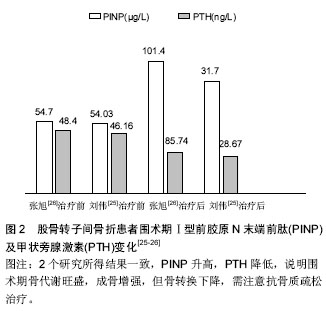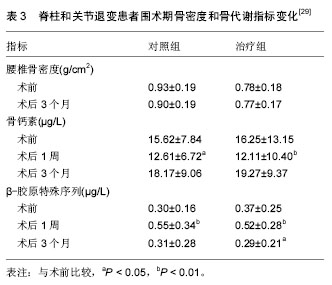| [1] Lee J,Vasikaran S.Current recommendations for laboratory testing and use of bone turnover markers in management of osteoporosis.Ann Lab Med.2012;32(2): 105-112.
[2] 欧萌萌,黄建荣.绝经后妇女骨质疏松症患者血清β-Crosslaps、PINP和N-MID检测的评价[J].标记免疫分析与临床,2011,18(4): 238-240.
[3] Michelsen J, Wallaschofski H, Friedrich N, et al.Reference intervals for serum concentrations of three bone turnover markers for men and women.Bone. 2013; 57(2):399-404.
[4] Mohamed Y, Haifa H, Datel O, et al.The role of biochemical markers of bone turnover in the diagnosis of osteoporosis and predicting fracture risk.Tunis Med. 2014; 92(5):304-310.
[5] Chopin F,Biver E,Funck-Brentano T,et al.Prognostic interest of bone turnover markers in the management of postmenopausal osteoporosis.Joint Bone Spine. 2012;79(1): 26-31.
[6] 张春萍,陆惠华,江尧湖,等.老年I型胶原特异性序列及骨密度与骨质疏松相关性分析[J].中国老年学杂志,2002, 22(4): 258-259.
[7] Szulc P, Delmas PD.Biochemical markers of bone turnover: potential use in the investigation and management of postmenopausal osteoporosis. Osteoporos Int. 2008; 19(12):1683-1704.
[8] Vasikaran S, Eastell R, Bruyère O, et al. Markers of bone turnover for the prediction of fracture risk and monitoring of osteoporosis treatment: a need for international reference standards. Osteoporos Int. 2011;22:391-420.
[9] Bauer D, Krege J, Lane N, et al.National Bone Health Alliance Bone Turnover Marker Project: current practices and the need for US harmonization, standardization, and common reference ranges. Osteoporos Int. 2012; 23(10):2425-2433.
[10] Vasikaran S, Cooper C, Eastell R, et al.International Osteoporosis Foundation and International Federation of Clinical Chemistry and Laboratory Medicine position on bone marker standards in osteoporosis.Clin Chem Lab Med. 2011; 49(8):1271-1274.
[11] 赵和平.P1N P、β-Crosslaps与绝经老年女性骨质疏松相关性研究[J].陕西医学杂志,2014,16(7): 865-866.
[12] Kim SW, Park DJ, Park KS, et al.Early changes in biochemical markers of bone turnover predict bone mineral density response to antiresorptive therapy in Korean postmenopausal women with osteoporosis. Endocr J. 2005; 52(6):667-674.
[13] El Maataoui A, Biaz A, El Boukhrissi F, et al.Association between sex hormones, bone remodeling markers and bone mineral density in postmenopausal women of Moroccan origin (cross-sectional study)].Pan Afr Med J. 2015; 22:106.
[14] Dai Z, Wang R, Ang LW, et al.Bone turnover biomarkers and risk of osteoporotic hip fracture in an Asian population.Bone. 2016; 83:171-177.
[15] Delmas PD.Biochemical markers of bone turnover.J Bone Miner Res.1993;8(2):549-555.
[16] 施鸣,范璐,陈新.骨代谢标志物与骨质疏松的相关性研究[J].标记免疫分析与临床,2012,19(6):351-353.
[17] Bauer DC,Garnero P,Harrison SL,et al.Biochemical markers of bone turnover, hip bone loss, and fracture in older men: the MrOS study.J Bone Miner Res.2009; 24(12):2032-2038.
[18] Delmas PD, Licata AA, Reginster JY, et al.Fracture risk reduction during treatment with teriparatide is independent of pretreatment bone turnover.Bone. 2006; 39(2):237-243.
[19] 范永前,张旭,林伟龙,等.股骨粗隆间骨折骨代谢生化指标测定[J].中国骨与关节损伤杂志,2013,28(12): 1140-1142.
[20] 童明宏,肖国平,丁慧.骨质疏松症与骨转换标志物的相关性研究[J].检验医学,2013,28(2): 111-113.
[21] Meier C,Nguyen TV,Center JR,et al.Bone resorption and osteoporotic fractures in elderly men: the dubbo osteoporosis epidemiology study.J Bone Miner Res.2005;20(4):579-587.
[22] Civitelli R,Armamento-Villareal R,Napoli N.Bone turnover markers: understanding their value in clinical trials and clinical practice.Osteoporos Int.2009;20(6): 843-851.
[23] Cheung AM, Majumdar S, Brixen K, et al.Effects of odanacatib on the radius and tibia of postmenopausal women: improvements in bone geometry, microarchitecture, and estimated bone strength.J Bone Miner Res. 2014; 29(8):1786-1794.
[24] Gleason CE, Dowling NM, Wharton W, et al.Effects of Hormone Therapy on Cognition and Mood in Recently Postmenopausal Women: Findings from the Randomized, Controlled KEEPS-Cognitive and Affective Study.PLoS Med. 2015; 12(6):e1001833; discussion e1001833.
[25] 刘伟,张旭,范永前,等.股骨粗隆间骨折患者手术前后骨代谢、骨密度和骨强度变化研究[J].实用骨科杂志,2014, 20(5):415-419.
[26] 张旭,林伟龙,李慧林,等.老年股骨粗隆间骨折患者围手术期的血骨代谢指标[J].复旦学报(医学版),2014,41(5): 706-707,710.
[27] 石磊,薛庆云,张启维,等.中老年人骨科围手术期有关骨代谢指标变化的研究[J].中华骨质疏松和骨矿盐疾病杂志, 2009,2(2):99-103.
[28] 王旭,张会英,娄路馨,等.脊柱退行性疾病需手术治疗患者骨代谢指标与骨密度关系的研究[J].中华检验医学杂志,2016,39(4):267-271.
[29] 石磊,纪泉,张啟维,等.鲑鱼降钙素对老年骨科手术后患者骨代谢的影响[J].中华骨质疏松和骨矿盐疾病杂志,2014, 7(3):227-232. |
.jpg)



.jpg)
.jpg)